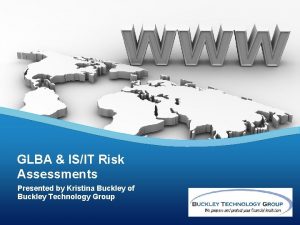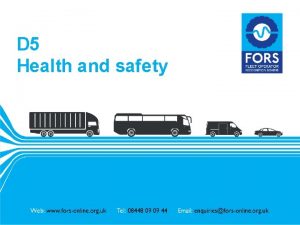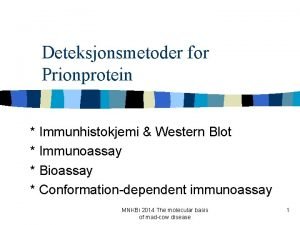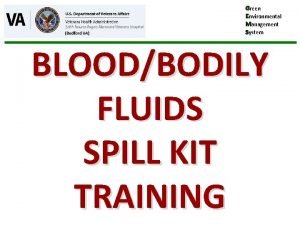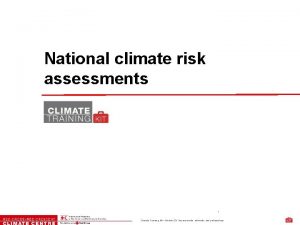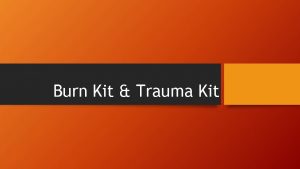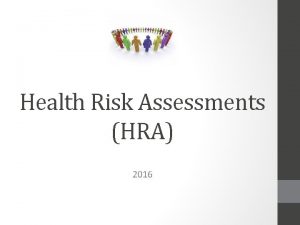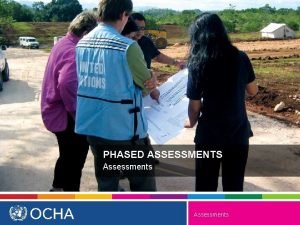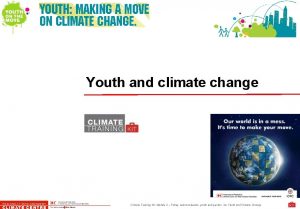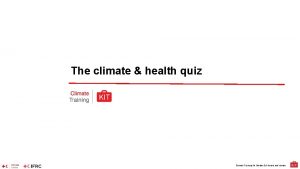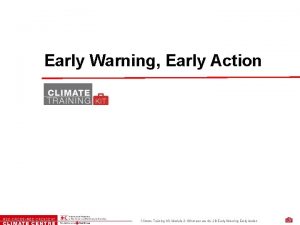National climate risk assessments Climate Training Kit Module












- Slides: 12

National climate risk assessments Climate Training Kit. Module 1 a: Science and impacts

• National climate risk assessments - a key first step! Over 60 Red Cross Red Crescent assessments have been compiled over the past 10 years Climate Training Kit. Module 1 a: Science and impacts

Evidence of local impacts • Use available country data • Involve communities • Involve other stakeholders, including your meteorological office. Climate Training Kit. Module 1 a: Science and impacts

Main focus of national climate risk assessments 1. Describe current climate risks and situation 2. Describe climate trends and projections 3. Impacts and vulnerability 4. Reflect how these impacts affect your work 5. Action Plan (optional) Climate Training Kit. Module 1 a: Science and impacts

National climate risk assessment Step 1: Describe the current situation in your country Geography Climate Vulnerabilities Photo: IFRC Climate Training Kit. Module 1 a: Science and impacts

National climate risk assessment Step 2: Climate trend and projections information can be found at sources such as: - Your meteorological office - National adaptation plans - UNFCCC - IPCC - World Bank Climate Change Knowledge Portal - IFRC/IRI Map. Room - UNDP country profiles (2010) Climate Training Kit. Module 1 a: Science and impacts

National climate risk assessment Step 3: Impacts and vulnerability How can climate change affect existing problems of vulnerable people? Climate Training Kit. Module 1 a: Science and impacts

National climate risk assessment Step 4: Reflect how the climate related impacts affect your work Photos: ICRC & IFRC Photo: IFRC Climate Training Kit. Module 1 a: Science and impacts

The assessment can have multiple purposes Ensuring the needs of the most vulnerable people are addressed in climate change policies Kenya National Adaptation Plan Main messages can be captured in campaigns or awareness raising Photo: Climate Centre Highlighting humanitarian consequences of climate change Awareness raising Photo: Ollivier Girard / IFRC Policy dialogue Pakistan heat wave actions pamphlet Climate Training Kit. Module 1 a: Science and impacts

Create an action plan How do we consider the climate risk assessment in our work (of different departments)? Disaster management and DRR Climate (change) risks 1. Brainstorming of ideas 2. Prioritizing 3. Assessing funding opportunities 4. Assess opportunities for integrating into existing projects (do not define standalone climate change projects) Health & Care Water & Sanitation Food Security etc. Climate Training Kit. Module 1 a: Science and impacts

Limits and complexity of the assessments Level of uncertainty: how to communicate probability? How to explain that climate projections cannot be downscaled ('zoomed in') to a province or community level? Climate Training Kit. Module 1 a: Science and impacts

National climate risk assessment – some tips: Keep it real and relevant • Don’t include things that you can’t explain • Use diagrams to clarify • Use quotes and pictures that tell the story better Keep it simple and understandable • Don’t confuse readers with too much complex data List your sources • To recheck information and make your report more credible Climate Training Kit. Module 1 a: Science and impacts
 Glba risk assessment requirements
Glba risk assessment requirements Fors-online.org.uk
Fors-online.org.uk Liquidity measures
Liquidity measures Yosin hitomi
Yosin hitomi Mechanical components kit for flexrio module development
Mechanical components kit for flexrio module development Comparative proteomics kit ii western blot module
Comparative proteomics kit ii western blot module Western blot sandwich
Western blot sandwich Comparative proteomics kit ii western blot module
Comparative proteomics kit ii western blot module Carmelego
Carmelego American heart association cpr in schools training kit
American heart association cpr in schools training kit Mcitp sql 2012
Mcitp sql 2012 Spill kit training presentation
Spill kit training presentation C device module module 1
C device module module 1
